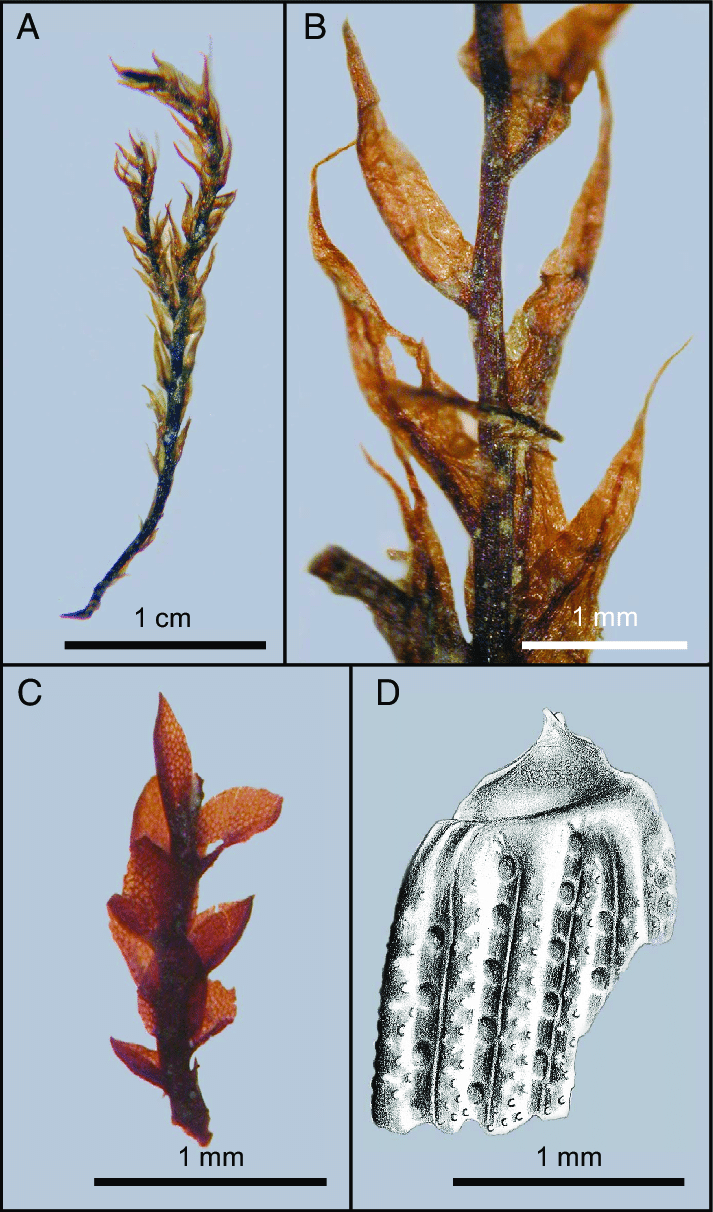
image from: https://ikilog.biodic.go.jp/LifeSearch/detail/?life_darwincore_id=10477174
Exploring the Fascinating World of Clastobryella laxifolia Moss
Introduction
Mosses may be small, but they play a big role in many ecosystems around the world. One particularly interesting species is

image from: https://www.researchgate.net/figure/Fossil-mosses-and-a-beetle-A-Stem-and-leaves-of-the-semiaquatic-moss-Drepanocladus_fig3_23148177
Clastobryella laxifolia (Thér.) Broth., a moss in the Sematophyllaceae family. In this blog post, we’ll take a closer look at this fascinating little plant, from its unique morphology to its global distribution and ecological importance. Get ready to dive into the captivating world of Clastobryella!
Background on Mosses
Before we focus on C. laxifolia

image from: https://www.semanticscholar.org/paper/What-is-Clastobryella-tenella-M.Fleisch.-Shevock/14ef83eb97d254de162dd154ccd0ba761033f775/figure/0
specifically, let’s review some background on mosses in general. Mosses are non-vascular plants in the division Bryophyta. Unlike other land plants, they lack true roots, stems, and leaves. Instead, they have root-like rhizoids, a stem-like structure called a seta, and leaf-like structures called phyllids. Mosses reproduce via spores rather than seeds and require water for sexual reproduction. There are over
image from: https://linnet.geog.ubc.ca/Atlas/Atlas.aspx?sciname=Ramalina pollinaria
12,000 species of moss found all around the world, from the Arctic to the tropics.
Morphology and Identification
Clastobryella laxifolia is a small, delicate moss with a creeping growth habit. Its stems are slender and irregularly branched, reaching about 1-3 cm long. The leaves are ovate-lanceolate, spreading, and often slightly twisted when dry. A key identifying feature is the single costa (midrib) that extends about 1/2 to 2/3 the length of the leaf. Leaf margins are entire (smooth) and the leaf cells are elongate and smooth.
The species gets the name “laxifolia” from the Latin “laxus” meaning loose and “folium” meaning leaf, referring to the spreading, loosely-arranged leaves. Capsules are rare, but when present are ovoid and borne on a
image from: https://southwalesbryos.blogspot.com/2017/01/homage-in-hepste.html
3-5 mm long seta. C. laxifolia can be distinguished from the similar C. robusta by its smaller size and shorter leaf costa.
Global Distribution and Habitat
Clastobryella laxifolia has a wide but scattered distribution across the tropics and subtropics. It is found in parts of Central and South America, Africa, Southeast Asia, Australia, and various Pacific islands. The species typically grows on the trunks and branches of trees as an epiphyte in moist forests from lowlands to about 2000 m

image from: https://www.flickr.com/photos/191586631@N05/52262187972
elevation. It seems to prefer semi-shaded sites with high humidity.
Ecological Roles and Adaptations
Like other epiphytic mosses, C. laxifolia plays important ecological roles in its forest habitats. It helps capture and retain moisture and nutrients that might otherwise be lost and provides microhabitats for various invertebrates. The species shows adaptations to its epiphytic lifestyle, including its creeping, mat-forming growth habit that allows it to cling to bark and its ability to dry out and rehydrate quickly to survive periodic drying.
image from: https://www.researchgate.net/figure/Hygrobiella-laxifolia-Hook-Spruce-an-alpine-species-occurring-in-deep-gorges-of_fig1_344462073

image from: https://macroalgae.org/portal/collections/individual/index.php?occid=990237

image from: https://panamabiota.org/stri/collections/individual/index.php?occid=906718
| Characteristic | Description |
|---|---|
| Family | Sematophyllaceae |
| Genus | Clastobryella |
| Species | C. laxifolia |
| Plant Size | Small, 1-3 cm long |
| Leaves | Ovate-lanceolate, spreading, single costa |
| Habitat | Epiphytic in moist tropical forests |
| Distribution | Scattered across tropics and subtropics |
| Ecological Roles | Moisture and nutrient retention, microhabitats |
| Adaptations | Creeping growth habit, desiccation tolerance |
Conclusion
image from: https://www.researchgate.net/figure/Photographs-of-the-15-unrecorded-Fissidens-in-Korea-A-F-bryoides-var-esquirolii_fig1_350527145
Clastobryella laxifolia may be a small and inconspicuous moss, but it has a fascinating morphology, ecology, and distribution. From the rainforests of the Amazon to the mountains of Papua New Guinea, this little species plays an important role in its ecosystems. Next time you’re in a tropical forest, take a closer look at the trees – you just might spot a patch of Clastobryella making its home on the bark!
What other secrets do you think the world of mosses holds? With thousands of species out there, who knows what other fascinating stories there are to uncover. One thing is for certain – these tiny plants are truly remarkable!